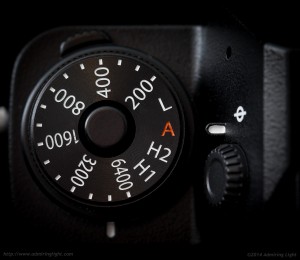Classic Chrome
Fuji has added a new film simulation for their JPEG engine, and it’s an outstanding one. The new Classic Chrome simulation emulates Kodachrome, providing slightly muted colors and rich contrast that simply looks fantastic. Even as one who likes a bit of color pop in my images, I love the look from the Classic Chrome simulation. I’ve actually been using the setting in Lightroom on my X-T1 RAW files since the recent release of Lightroom 5.7. Now with the new firmware, I have to say that the JPEG implementation is fantastic. If you don’t need to shoot RAW, Fuji’s outstanding JPEGs have gained another outstanding option.

Natural EVF
Fuji has also created a setting (listed in the Screen Set-Up menu as “Preview Pic Effect”) that when turned off removes the JPEG processing from the EVF and rear screen to provide for better shadow detail when composing. I like it, though I wish that it also allowed for color shooting when using a black and white film simulation. In a similar move, they’ve also expanded ‘preview exposure in manual mode’ to include a white balance setting, allowing for you to set white balance for flash while shooting in a different color light, while still seeing a nice clear color balanced image in the viewfinder.
Autofocus Improvements
This is the undocumented feature. There have been rumblings and a confirmation from Rico Pfirstinger (through his ties with Fujifilm Germany) that the autofocus algorithms in the X-T1 have been given the updates that the X100T received. The result is a bit faster and more sure autofocus in dimmer light. It’s not a huge change, but I do feel it’s noticeable. This was a very pleasant surprise.
Spot metering tied to focus point
Another great feature that the X-T1 now has is the ability to tie spot metering to the active focus point. This is an extremely useful feature, especially when shooting in backlit scenarios.
Omissions
While it’s really hard to complain when an update of this breadth is given to existing users for free, there are a few things that Fuji shooters have desired for a very long time that have still not been addressed. I’m going to talk about three in hopes that the next firmware update finally adds these features.

- Better Bracketing. This has been a complaint since the first firmware on the X-Pro1, and I fail to understand how it hasn’t been addressed. Fuji’s bracketing option is limited to a paltry +/- 1 EV for three shots. That’s it. It’s the worst specced bracketing in the industry, and I can’t see any reason why this couldn’t be implemented in a single day of programming. When competitors like Sony have +/- 3 stops of bracketing for 3 shots (resulting in a 6 stop spread), Olympus has 7 shot bracketing and Fuji’s stuck at a measly 2 stop spread, something’s wrong. PLEASE fix this Fuji, on ALL your X-Series cameras.
- Exposure compensation with Auto ISO in Manual Mode. This is another thing that should be very easy to do. While Fuji has made their Auto ISO implementation relatively robust in the past year, it would be wonderful to have exposure compensation in manual mode. Then you could set your aperture, set your shutter speed, and let the ISO float for exposure, taking into account EC. Sony implements this beautifully (though they lack minimum shutter speed setting…why can’t these manufacturer’s nail it?).
- Please open the extended ISOs to RAW. It’s such an arbitrary decision to limit ISO 100, 12,800 and 25,600 (or 51,200 if you really enjoy noise) to JPEG only. No other manufacturer does this. I understand it’s a software implemented ISO, but this is about convenience. Sure, I can set ISO 6400 and underexpose by one stop for 12,800 and two stops for 25,600 and then bring them up in post, but that’s two added steps to the process for no discernible purpose.
Conclusion
Fuji has enabled a tremendous amount of new features in the X-T1 (and a fair few in the X-E2 as well). It’s a great gesture of goodwill to their customers. This update enables a host of very useful features and makes the X-T1 an even better camera than it already was. Make sure to read the release notes from Fujifilm to see all the features, including 24p video and manual control of video for those of you who enjoy the filmmaking side of things. Updates like this are what breeds customer loyalty. Other companies should take notice. Thanks Fuji!





Leave a Reply